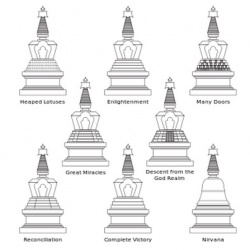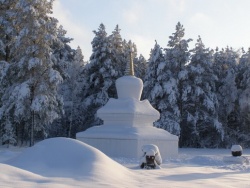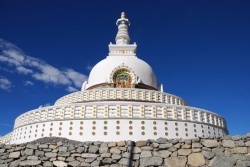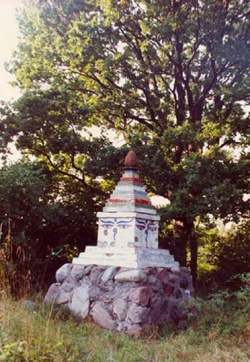Stupas symbols of enlightened mind
By Sylvia Somerville
As Buddhism makes its way into a new land, not far behind come stupas, sacred monuments that embody the enlightened mind. Stupas exist in every Buddhist country in the world—from India to Indonesia—and in every Buddhist tradition. Now that Buddhism has taken hold in the United States, stupas are becoming an architectural feature of the American landscape and places of pilgrimage for those seeking their blessings.
What are stupas?
Stupas are an ancient form of sacred architecture that represent the heart of enlightenment—not just as a form of tribute, but as a radiating presence that transmits blessings to all those who come in contact with them. If properly constructed and empowered, a stupa is like a spiritual generator, broadcasting virtue of such power that it brings peace and harmony to all beings and balances the forces of nature.
Because most Westerners don’t understand the vocabulary of the sacred, it is hard for us to grasp that a stupa has inherent spiritual value or can function like an architectural blueprint for enlightenment. For us, monuments are rock edifices or three-dimensional works of art. They are places to remember and grieve or pay tribute to heroes and historical events—not to be transformed. Our culture and architectural iconography has not prepared us to understand stupas as a living presence that can call forth our potential for enlightenment.
How can we begin, then, to understand stupas as the quintessential symbol for spiritual awakening and a roadmap towards an open heart? Studies of symbolism, experience and faith provide a doorway. In his book, The Symbolism of the Stupa, Adrian Snodgrass explains that meanings are not read into a symbol or superimposed upon it. They exist within a symbol’s form in a manner analogous to natural laws inhering within physical phenomena. “The significance of the stupa form is integral to the form itself and lies there prior to perception,” writes Snodgrass. It functions even if it is not understood. Thus stupas communicate to the whole human being, not only to the mental faculties.
So what are stupas saying? Stupas speak of enlightenment on many different levels. The outer form of a stupa represents a meditating Buddha, seated and crowned. When seen from above, a stupa is a perfect mandala, a pure distillation of the universe.
But that is only the beginning of a stupa’s meaning. Every architectural feature of the stupa symbolically represents a facet of the spiritual path. For example, a stupa incorporates five basic geometric shapes that correspond to the five elements. Each element, in turn, corresponds to an essential attribute of a fully awakened being. The square base of the stupa represents earth and equanimity; the round dome, water and indestructibility; the triangular spire, fire and compassion; the semi-circular umbrella, wind and all-accomplishing action; and at the very top, the jewel-shaped tigle or drop represents space and all-pervading awareness.
On a more general note, the configuration of the entire universe as conceived in traditional Buddhist cosmology is a gigantic stupa—as is the structure of a person’s subtle body. Thus the inner level of experience relates directly to the physical cosmos, and a stupa is a gateway for merging the innate wisdom nature with the Dharmadatu or “field of dharma” that has no beginning and no end.
Where do stupas come from?
Stupa is a Sanskrit word that literally means “to heap” or “to pile up.” Some scholars believe that stupas predated Buddhism and originally were mounds of dirt or rocks built to honor dead kings. Later, they say, the Buddha imbued them with spiritual meaning. This explanation runs counter to Buddhist tradition, which maintains that because the stupa conveys enlightened qualities, it could only have been revealed by the mind of enlightenment. Thus stupas have been around as long as there have been enlightened beings, long before the Buddha of our age—Shakyamuni—lived in India in 2,500 BC.* In fact, some stupas, such as the Swayambhunath Stupa in Nepal, are believed to be self-arising expressions of enlightenment.
There is no doubt, however, that Shakyamuni Buddha ignited an appreciation for the spiritual potency of stupas. The Buddha taught and demonstrated that stupas are powerful agents of purification and spiritual transformation. On one occasion he sent a dying man to restore and reconsecrate a stupa in disrepair. After the Brahmin completed the work according to the Buddha’s instructions, his body became miraculously strong and majestic.
When it was time for Buddha Shakyamuni to pass into nirvana, he instructed his followers to cremate his body and place his relics in a stupa so that people of future generations could make a connection with Buddhism and experience the Buddha’s blessings. What followed, was a tradition of stupa-building that resulted in many thousands of stupas being built all over Asia.
What makes stupas potent?
As Buddhism moved from culture to culture, the outer appearance of the stupa changed not only in size and materials, but also in its shape. In each country, different facets of the stupa’s form were emphasized. In Tibet, the stupa was placed on a lion throne and elaborately detailed. In Nepal, the dome was emphasized, and eyes were painted on the harmika (throne of the spire). In Korean, Chinese and Japanese pagodas, the spire became the focal point. When looking at these structures superficially, it may seem that they represent separate architectural traditions. In fact they do not. Snodgrass points out that what makes a stupa a stupa is its internal symmetry and orientation in space. These and other specific instructions come directly from the Buddha and have been codified in the Drimed Namnyiy or the “Two Stainless Cycles.”
In addition to the stupa’s exacting specifications, there are two other key elements for energizing the power of stupas. First are the ritual offerings that are placed inside the stupa, such as relics, representations of sacred seed syllables called mantras, small clay stupas called tsa-tsas and worldly offerings. Then comes the consecration after the stupa is built.
All of the sacred objects within a stupa activate and amplify its enlightened power. Most notable are the relics. Although the Teravadin tradition focuses exclusively on the relics of the Buddha, the other two schools of Buddhism—the Mahayana and the Vajrayana—also embrace the relics of great realized masters. Citing Buddhist scriptures, they maintain that every element of an awakened being’s body is pervaded with enlightenment. Thus, even after cremation, the remains are considered sacred because they are the distilled essence of realization. In Tibetan Buddhism, especially, it is customary to build a stupa when a great teacher dies. Because the stupa embodies the teacher’s awakened mind, it becomes a place where students can still “meet” their teacher and invoke the teacher’s wisdom.
What are the benefits of building or sponsoring a stupa?
The blessings of a stupa are heaped upon its builders, the area where it is situated and the people who honor them. “When you build a stupa, you are building your own enlightenment,” says the Venerable Gyatrul Rinpoche, director of several Tibetan Buddhist centers on the West Coast and Mexico. That doesn’t mean that just anyone can build a stupa, however. Great care goes into the building of a stupa—from very specific measurements to the handling of items that go inside. To build a stupa requires special instructions, prayers, offerings, dietary requirements and the blessing of a Buddhist lama as well as considerable physical, spiritual, emotional and financial resources. It is not uncommon for the building of a stupa to be delayed because a stupa master is unavailable to guide the project. Some enlightened masters make stupa building their life’s work and travel from country to country, site to site, to oversee stupa construction.
Still, most stupa builders are inexperienced and are motivated to push themselves beyond what they know to create something precious that will live long after they die. “We’re not only transplanting a tradition, we are also proclaiming the possibility of an enlightened society,” says Joshua Moulder, a stupa builder and director of art and design for the Great Stupa of Dharmakaya that Liberates Upon Seeing. Located in Feathers Lake, Colorado, this stupa has been more than a decade in the making. Hundreds of volunteers have worked tirelessly building the 108-foot stupa, making the offerings that go inside and decorating the four elaborate shrine rooms that will be used for Buddhist practice. Work continues to prepare the stupa for its consecration next year.
By building or sponsoring a stupa with an aspiration to be of benefit to others, one alters the karmic fabric of one’s destiny, becoming inextricably linked with the mind of enlightenment. In the Legend of the Great Stupa, a sacred treasure text or terma, the great tantric Buddha of Tibet, Guru Padmasambhava, reveals how his own enlightenment was assured by building the Jarungkhaskor stupa in Boudhnath, Nepal, which attracts thousands of pilgrims to this day. Many sacred texts enumerate the blessings that come from building a stupa, which encompass both temporal and spiritual benefits.
People who have built stupas say the experience has been life-changing. Over the last 15 years, members of Kunzang Palyul Choling (KPC), a Tibetan Buddhist center with a growing community in Sedona, Arizona, have built nearly four dozen stupas and are getting ready to build a 36-foot enlightenment stupa this year. Those who have built stupas before can’t wait to begin. For David Somerville, a stupa builder for KPC, “Building stupas has jettisoned me off a stagnant plateau of spiritual growth—where I stayed within my comfort zone—and put me into a different orbit. Before I built stupas, I didn’t believe that any kind of real spiritual progress was possible in this life. Within two years of building my first stupa I felt that there was a fire burning inside me that hadn’t been there before, and I knew I could make a difference in this lifetime.”
Even realized masters jump at the opportunity to be involved with a stupa because they appreciate its value. “When we were creating the stupa in Bhutan commemorating H.H. Kyentse Rinpoche, there was never any need to exhort people to work,” recalls Tulku Sang-ngag Rinpoche, an enlightened master and stupa builder. “Not only were the great lamas there day and night making tsa tsas, rolling mantras and so forth, but people were flocking to help….Because it was wintertime and really cold, building the sides of the stupa was extremely hard work. Yet lamas and tulkus (enlightened masters who reincarnate to benefit beings) were practically racing each other for the honor of being able to get up the scaffolding and start plastering.”
How do stupas transform us?
Stupas are well-known for bringing benefit to the communities in which they are built. They bring prosperity, well-being, harmony and joy to the residents and pacify the environment, preventing natural disasters. Just to see a stupa, to walk around it or to feel the wind blowing by it is a blessing and purifies negative propensities—whether a person knows anything about stupas or not. But it is possible to increase the potency of the experience by approaching a stupa with respect and an altruistic motivation to benefit others. It is said that by honoring a stupa, we honor our own potential for enlightenment.
Traditionally, pilgrims prostrate, circumambulate and make offerings at stupas for both short-terms goals, such as longevity, prosperity, health and the success of an undertaking, as well as the ultimate goal of enlightenment. It is also customary to make prayers around stupas for the sick, troubled or deceased.
By prostrating before a stupa, we turn our face away from our egos and toward our enlightened nature. By circumambulating—walking around the stupa in a clockwise fashion and reciting prayers—we keep the image of enlightenment at the center of our attention By making offerings of what we hold dear, we cut through our self-interest. All these activities become the virtue that helps us achieve our goals and moves us forward on the spiritual path. The more we are focused on the benefit to others, the greater the blessings for ourselves and all sentient beings.
Sylvia Somerville is a practicing Buddhist and freelance writer and editor living in Sedona, Arizona. She dedicates this article to the long life of her teacher Jetsunma Ahkon Lhamo with gratitude for her many blessings.
According to Buddhist teachings, there have been three other Buddhas prior to Shakyamuni in our eon, and there are nearly 1,000 more to come.




